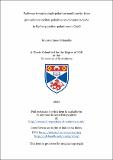Files in this item
Pathways towards single-polariton nonlinearity : from ground state exciton-polariton condensates in GaAs to Rydberg exciton-polaritons in Cu₂O
Item metadata
| dc.contributor.advisor | Ohadi, Hamid | |
| dc.contributor.author | Orfanakis, Konstantinos | |
| dc.coverage.spatial | 220 | en_US |
| dc.date.accessioned | 2023-03-23T12:52:53Z | |
| dc.date.available | 2023-03-23T12:52:53Z | |
| dc.date.issued | 2023-06-12 | |
| dc.identifier.uri | https://hdl.handle.net/10023/27247 | |
| dc.description.abstract | This work explores several routes towards achieving single-polariton nonlinearity. Exciton-polaritons are part-light part-matter quasiparticles arising from the strong coupling of excitons and cavity photons in micron-sized optical cavities. Owing to their excitonic component, polaritons can be described as "dressed photons" with nonlinear interactions several orders of magnitude larger than in typical optical materials. However, interactions between microcavity polaritons have remained weak, with the single-polariton nonlinearity being much smaller than the cavity linewidth. In this thesis, two approaches are studied as a way of circumventing this limitation and entering the nonlinear regime. The first approach involves narrowing the emission linewidth of a polariton condensate through optical confinement so that the linewidth approaches the interaction constant. The second approach involves exploiting the giant nonlinearities of Rydberg excitons in cuprous oxide, first in nanoparticles to study the effect of quantum confinement and then inside a microcavity to create highly nonlinear Rydberg exciton-polaritons. The main result presented in this thesis are: (1) An optically trapped polariton condensate in a state-of-the-art GaAs-based microcavity approaches but still remains away from the regime of single-polariton nonlinearity. The condensate is characterised by an ultra-narrow linewidth as evidenced by the temporal decay of its coherence. The latter also exhibits an oscillatory behaviour originating from a beating between two condensate modes. (2) Rydberg excitons states are resolved up to principal quantum number n = 6 in the absorption spectrum of clusters of cuprous oxide nanoparticles. Rydberg excitons are also resolved for single nanoparticles; however, the spectrum is dominated by effects inherent to the nanoparticle system, thus hindering the study of the nonlinearity of Rydberg excitons in this quantum-confined structure. (3) Strong coupling between cavity photons and Rydberg excitons can be achieved by embedding a thin cuprous oxide crystal as the active layer of an optical microcavity. Even though the microcavity is below the nonlinear regime for all strongly coupled Rydberg states, non-classical light can be observed by reducing the mode volume and suppressing the phonon-background of cuprous oxide in future microcavities. This thesis is a major step towards realising single-polariton nonlinearity for future quantum applications. The results presented in this work highlight the limitations of traditional GaAs-based semiconductor microcavities while establishing Rydberg polaritons with their huge nonlinearities as a promising route for achieving a scalable, strongly correlated photonic platform. | en_US |
| dc.language.iso | en | en_US |
| dc.subject | Nonlinearity | en_US |
| dc.subject | Exciton | en_US |
| dc.subject | Polariton | en_US |
| dc.subject | Condensate | en_US |
| dc.subject | Rydberg | en_US |
| dc.subject | Cu₂O | en_US |
| dc.subject | GaAs | en_US |
| dc.title | Pathways towards single-polariton nonlinearity : from ground state exciton-polariton condensates in GaAs to Rydberg exciton-polaritons in Cu₂O | en_US |
| dc.type | Thesis | en_US |
| dc.contributor.sponsor | Engineering and Physical Sciences Research Council (EPSRC) | en_US |
| dc.type.qualificationlevel | Doctoral | en_US |
| dc.type.qualificationname | PhD Doctor of Philosophy | en_US |
| dc.publisher.institution | The University of St Andrews | en_US |
| dc.identifier.doi | https://doi.org/10.17630/sta/363 | |
| dc.identifier.grantnumber | EP/L015110/1 | en_US |
This item appears in the following Collection(s)
Items in the St Andrews Research Repository are protected by copyright, with all rights reserved, unless otherwise indicated.

